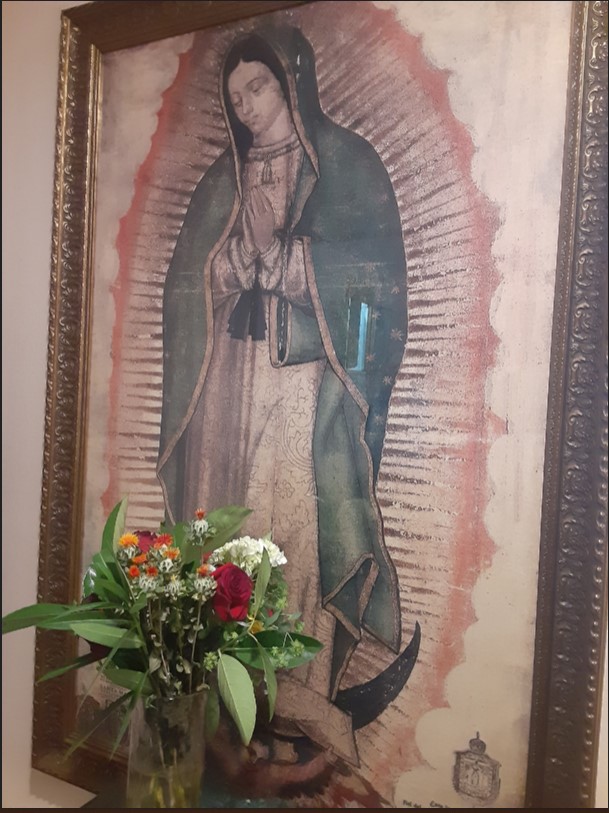
Our Lady of Guadalupe: Who is She and what is her Significance?
Although Hispanic Heritage Month has almost drawn to a close, I wanted to talk about one of the most iconic images in Hispanic culture: Our Lady of Guadalupe.
Her image appears in all sorts of places, from Catholic churches and religious candles to jewelry, t-shirts, and even tattoos. Although her image has been seen in many places, specifically in Mexico and Texas, not many people know the origins of this sacred image and what it means to those who revere it. So, who is this woman, and why is she so revered?
Our Lady of Guadalupe is an apparition of the Virgin Mary as she appeared in Mexico circa December 1531. As detailed in the Nican Mopohua, a text written in the native Nahuatl language by Don Antonio Valeriano, the Virgin Mary appeared on Tepeyac Hill (located in modern Madero in Mexico City) to Juan Diego, a Chichimec peasant who had converted to Catholicism.
In the Nican Mopohua, the Virgin Mary appears to Juan Diego and requests that he tell the bishop to build a temple on Tepeyac Hill. The Virgin Mary appears as an indigenous woman, more specifically a mestiza—a woman of mixed indigenous and Spanish heritage—and speaks Juan Diego’s native Nahuatl language. Juan Diego goes to tell the Bishop of this miracle, but is rejected multiple times until he provides a sign proving the miracle of the apparition. The Virgin Mary obliges to give Juan Diego the sign the next day, but his uncle falls ill. Juan Diego avoids Tepeyac hill in order to find a priest to hear his uncle’s confession before he dies. The Virgin Mary intercepts Juan Diego, reassures him that his uncle will live, and tells him to go to the hill and pick the flowers that appear there. Juan Diego goes to the hill and finds many flowers that would not normally grow on the rocky, harsh grounds of Tepeyac hill. Juan Diego carries the flowers in his tilma, and when he drops the flowers in front of the bishop, the Virgin Mary’s image is revealed on his tilma. Now Juan Diego’s tilma is shown in the Basilica. Her apparition to Juan Diego and image on his tilma is said to have led to many Aztec conversions to Catholicism, helped unify the indigenous and the Spanish, and is now one of the most iconic images in Mexican culture.
Symbols in the Virgin Mary’s Appearance
Part of what makes Our Lady of Guadalupe’s image so different from other Marian apparitions is the distinct Aztec imagery that connects her to the indigenous peoples of Mexico. Starting with her features, Our Lady of Guadalupe presents herself not “white” but tanned skin, dark eyes, and dark hair. She is mestiza and has a combination of Aztec and Spanish features, thus she does not belong solely to the Spanish colonizers but to all peoples. Her loose hair signifies her virginity while the black ribbon around her waist represents her pregnancy with Jesus Christ. She wears a rose red tunic decorated with nine different flowers. It is thought that the color represents dawn, the start of a new era. The nine flowers represent the nine tribes from Aztlan (located in present-day Mexico City). Her mantle is a bluish-green hue and is covered in stars. This color represents life and fertility and in the Aztec culture is associated with the gods and royalty while the stars mark her as coming from heaven. In just these details, she visually shows herself to the indigenous as the Queen of Heaven.
Despite this status, her eyes are cast downward in humility and distinguishes herself as human, not a god. Her hands are also in prayer, as she prays to God and is not a deity herself. She stands in front of the sun, its rays shining out from behind her, signifying her as greater than the sun god, Huitzilopochtli. She stands on a crescent moon, visually showing her power over the moon god or the god of darkness. An angel (who also appears as indigenous) holds her mantle and the hem of her tunic. She is unified with heaven, represented in her mantle, and earth, represented in her tunic.
There are more details and symbols in her image, than I’ve described her, but I hope this gives you a better understanding of her visual significance to the indigenous peoples of Mexico.
Her Meaning Now
In many ways this image is now synonymous with Mexico itself, but the religious context of this Marian apparition highlights the Christian idea of God not only to the natives of Mexico, or even to just the Americas, but the entire world. Her image visually represents God’s love for people of all heritages and backgrounds, and the beautiful unity we aspire to achieve through His grace.
